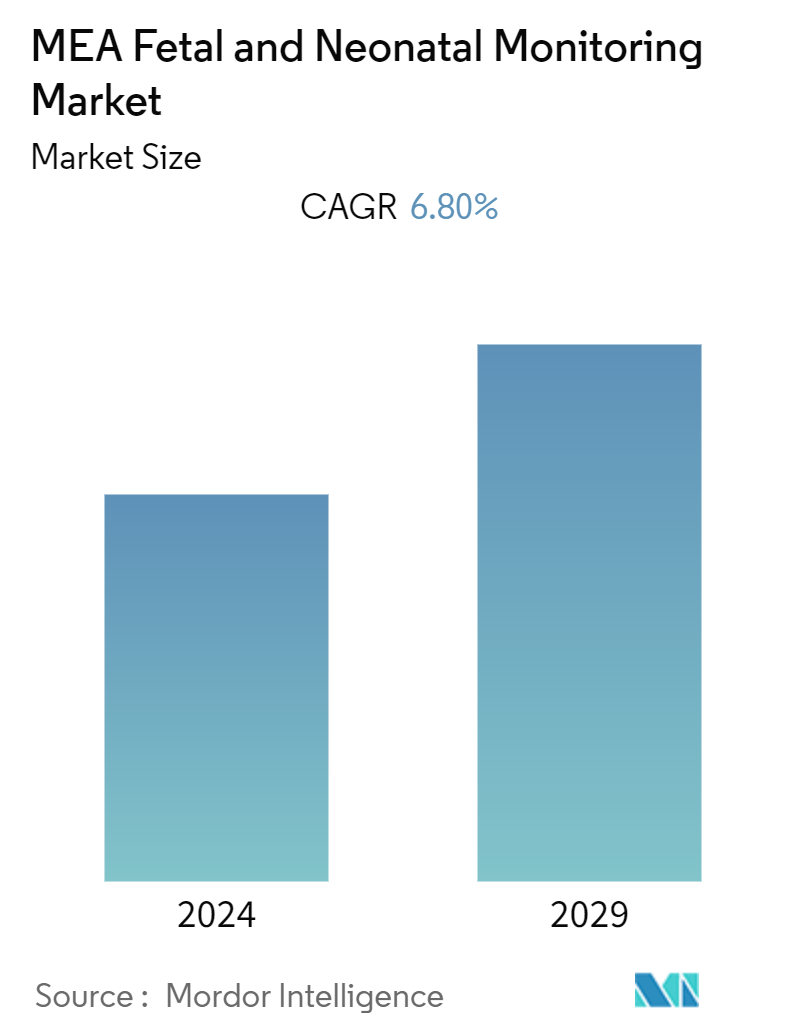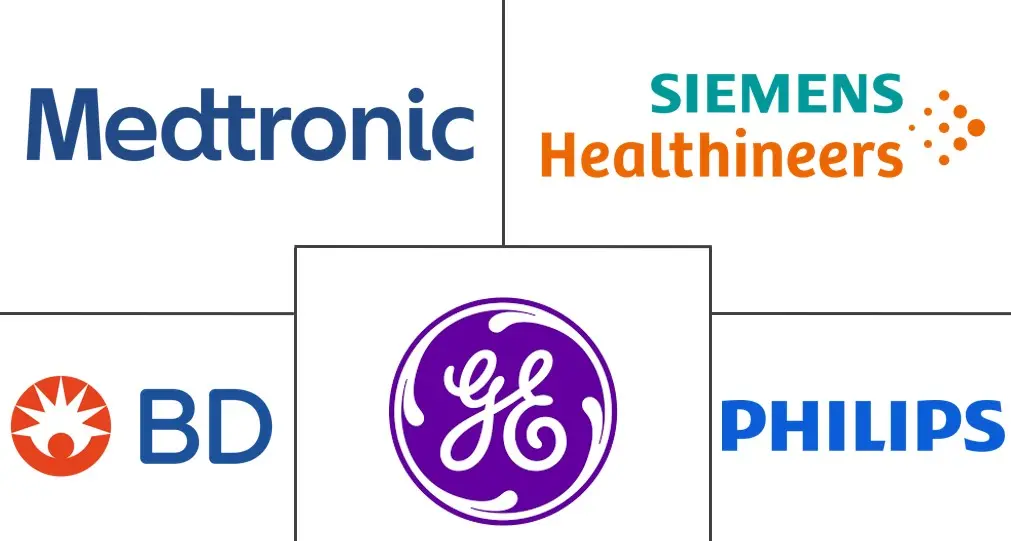Market Size of MEA Fetal & Neonatal Monitoring Industry

| Study Period | 2019 - 2029 |
| Base Year For Estimation | 2023 |
| Forecast Data Period | 2024 - 2029 |
| Historical Data Period | 2019 - 2022 |
| CAGR (2024 - 2029) | 6.80 % |
| Market Concentration | Medium |
Major Players
*Disclaimer: Major Players sorted in no particular order |
MEA Fetal & Neonatal Monitoring Market Analysis
The MEA Fetal & Neonatal Monitoring Market is expected to register a CAGR of 6.80% during the forecast period.
Fetal monitoring devices are crucial in gynecology and obstetrics, providing real-time insights into the fetus's health during labor and delivery. Similarly, neonatal devices are essential in neonatal intensive care units (NICUs), where specialized equipment and monitoring systems are tailored to the specific needs of newborns.
The prevalence of preterm births has increased in recent decades in these Middle Eastern countries. These preterm newborns are found prone to diseases and infections, which lead to death. For instance, according to the study published in the JAMA network in May 2022, neonatal preterm birth increased by a mean of 2.09% per year in Southern Sub-Saharan Africa. This high preterm death can be reduced using neonatal monitoring devices, which are expected to drive the market.
The growing awareness initiatives by the government and private organizations to create importance in fetal and neonatal care are expected to contribute to market growth over the forecast period. For instance, in November 2022, the Ministry of Public Health in Lebanon, collaborating with UNICEF, launched the National Newborn and Prematurity Campaign. The campaign aims to educate the public about the vital importance of providing quality healthcare to newborns and premature babies and highlight the crucial role families and healthcare providers play. Hence, these campaigns on newborns who should be kept under surveillance using monitoring equipment increase the demand for monitoring devices and equipment in the region and are expected to boost the market's growth over the forecast period.
Thus, a growing number of preterm birth and awareness initiatives by the government and private players is expected to contribute to market growth over the forecast period. However, the stringent regulatory procedures in the region are expected to hinder the development of the market over the forecast period.
MEA Fetal & Neonatal Monitoring Industry Segmentation
Fetal and neonatal monitoring device machines are used for monitoring and are designed to take care of the unique needs of unborn fetal and newborn babies.
The Middle East and Africa fetal and neonatal monitoring market is segmented by product, end-user, and geography. The market is segmented by product into fetal and neonatal monitoring devices. End-users segment the market into hospitals, neonatal care centers, and others. The market is segmented by geography into GCC, South Africa, and the rest of the Middle East and Africa.
The report offers the value (in USD) for the above segments.
| By Product | |||||||
| |||||||
|
| By End-User | |
| Hospitals | |
| Neonatal Care Centers | |
| Other End-users |
| By Geography | |
| GCC | |
| South Africa | |
| Rest of Middle East and Africa |
MEA Fetal & Neonatal Monitoring Market Size Summary
The Middle East and Africa fetal and neonatal monitoring market is poised for significant growth, driven by the increasing prevalence of preterm births and the rising awareness of neonatal care. Fetal monitoring devices play a crucial role in gynecology and obstetrics by providing real-time insights into fetal health during labor, while neonatal devices are essential in NICUs for newborn care. The growing number of preterm births, particularly in regions like Southern Sub-Saharan Africa, has heightened the demand for neonatal monitoring devices to reduce mortality rates. Government and private sector initiatives, such as campaigns by the Ministry of Public Health in Lebanon and UNICEF, are further propelling market growth by emphasizing the importance of quality healthcare for newborns and premature babies.
The market is characterized by a semi-consolidated landscape with key players like Becton, Dickinson and Company, GE Healthcare, Koninklijke Philips NV, Medtronic, and Siemens Healthcare GmbH leading the charge. These companies are actively engaging in partnerships and launching innovative products to enhance their market presence. The demand for cardiac monitoring devices is also on the rise due to the high incidence of preterm or low birth weight babies, which necessitate continuous heart rate monitoring. Additionally, initiatives such as the Centre of Excellence for Pre-natal Pediatrics at Latifa Hospital in Dubai are expected to expand the applications of cardiac monitoring, further driving market growth. Despite the challenges posed by stringent regulatory procedures, the market is expected to benefit from the increasing adoption of monitoring devices in countries like South Africa, where healthcare developments aim to reduce maternal and infant fatalities.
MEA Fetal & Neonatal Monitoring Market Size - Table of Contents
-
1. MARKET DYNAMICS
-
1.1 Market Overview
-
1.2 Market Drivers
-
1.2.1 Increasing Number of Preterm and Low-weight Births
-
1.2.2 Advanced Technology in Fetal and Prenatal Monitoring
-
-
1.3 Market Restraints
-
1.3.1 Stringent Regulatory Procedures
-
-
1.4 Porter's Five Forces Analysis
-
1.4.1 Threat of New Entrants
-
1.4.2 Bargaining Power of Buyers/Consumers
-
1.4.3 Bargaining Power of Suppliers
-
1.4.4 Threat of Substitute Products
-
1.4.5 Intensity of Competitive Rivalry
-
-
-
2. MARKET SEGMENTATION (Market Size by Value - USD)
-
2.1 By Product
-
2.1.1 Fetal Monitoring Devices
-
2.1.1.1 Heart Rate Monitors
-
2.1.1.2 Uterine Contraction Monitor
-
2.1.1.3 Pulse Oximeters
-
2.1.1.4 Other Fetal Monitoring Devices
-
-
2.1.2 Neonatal Monitoring Devices
-
2.1.2.1 Cardiac Monitors
-
2.1.2.2 Capnographs
-
2.1.2.3 Blood Pressure Monitors
-
2.1.2.4 Pulse Oximeters
-
2.1.2.5 Other Neonatal Monitoring Devices
-
-
-
2.2 By End-User
-
2.2.1 Hospitals
-
2.2.2 Neonatal Care Centers
-
2.2.3 Other End-users
-
-
2.3 By Geography
-
2.3.1 GCC
-
2.3.2 South Africa
-
2.3.3 Rest of Middle East and Africa
-
-
MEA Fetal & Neonatal Monitoring Market Size FAQs
What is the current MEA Fetal & Neonatal Monitoring Market size?
The MEA Fetal & Neonatal Monitoring Market is projected to register a CAGR of 6.80% during the forecast period (2024-2029)
Who are the key players in MEA Fetal & Neonatal Monitoring Market?
Becton, Dickinson and Company, Koninklijke Philips NV, Medtronic Plc, Siemens Healthcare GmbH and GE Healthcare are the major companies operating in the MEA Fetal & Neonatal Monitoring Market.

